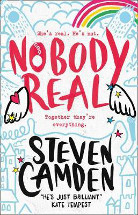Nobody Real by Steven Camden

HarperCollins, 2018. ISBN 9780008168384
(Age: 16+) Real or Not? This book teeters between reality for
the central character, Marcie, and the world and life of her
imaginary friend, Thor. The reader is always in a state of
uncertainty as the world of imaginary friendship is revealed. This
is not a straightforward or juvenile revelation. Marcie (or Mars as
she is often called) is dealing with an uncertain future as she
stands on the cusp of leaving school and facing the prospects to
come. Her secret 'friend' Thor is facing a transition of his own . .
. a transition that is revealed through his counselling sessions.
Maturity comes with all sorts of challenges.
Marcie's family life is complex and Thor has enabled her to survive
through the traumas of her childhood, but what will happen now that
childhood is disappearing? Her real-life friend, Cara, is ready to
launch, but Marcie is far from ready and their relationship is
showing the first signs of complication. Will Thor be able to
manipulate circumstances and her attitudes so she is ready to be the
person she should be? Coming out of her corner is fraught with
problems. Her father is a writer battling his own life-blocks and
with limited input into the personal dramas that she faces. His
battle with creativity is in juxtaposition to Marcie's imaginary
creation and the closeness and comfort that Thor brings. The angst
of the teenage Marcie, is replicated in the creative struggles of
her father.
This book is highly original, captivating and complex and requires
extreme persistence to unravel the unique floating 'voices' that
communicate Marcie's realities and the world of the imagination.
This confusion is part of what makes this an interesting read and
adds a level of intricacy and perhaps a hint of the manic or
perplexity that a mature reader would find worthy of persistence. I
liked the idea of the imaginary friend (creature) who is not ready
to fade from his critical role as confidante; but the complexity of
the journey will only be appreciated by those who read in
'meal-sized' portions, rather than a 'snack and nibble' approach, as
confusion will be a companion. If the identity of the narrator was
clearer (perhaps with chapter heading hints), then the reader would
not need to spend critical time re-reading sections to identify
whose voice is being heard, and whose feelings and identity is being
revealed. (Note: differing fonts used for different 'voices' do not
always clarify the confusion.) 'Living inside someone's head' is
inherently confusing, so the author has deliberately created mystery
as he reveals what is real and what is not.
Carolyn Hull